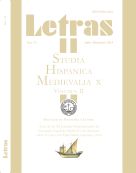Birds in the cancioneros: Zoo history, Symbology and Function of the Parrot in the Peninsular Lyrical Poetry from XIIIth to XVth Centuries
Keywords:
Zoohistory, Parrot, Galician-Portuguese Lyrical Poetry, XIVth Century, XVth CenturyAbstract
The Galician-Portuguese lyrical poetry contains very few references of animals. In the case of birds, for example, they are just mentioned there, without any specification. One of the few exceptions is a pastorela poem (B534, V137) by King Denis of Portugal (r. 1279-1325), where a parrot talks about love with a young shepherdess. Parrots, poets and nightingales interact in texts of the fourteenth and early fifteenth century, as the Libro de Buen Amor, Celestina, the Poem of Alfonso XI, and in love or satirical poems of some antiquiores and recentiores poets of the Cancionero de Baena (PN1), or the Cancionero de Palacio (SA7), such as the Marquis de Santillana. This article seeks to follow the possible zoohistorical and literary appearances of the parrot (not macaw parrot), beginning with its description in bestiaries, its mention in the Digenis Akritas, in the Occitan roman Novas del Papagai, the Sendebar or La doncella Theodor, and also in some iconography, trying to shed light on its symbolism and function as a messenger of love in Peninsular lyrical poetry.Downloads
Download data is not yet available.
Downloads
Published
2019-04-22
How to Cite
del Río Grande, M. G., & Raposo, C. I. (2019). Birds in the cancioneros: Zoo history, Symbology and Function of the Parrot in the Peninsular Lyrical Poetry from XIIIth to XVth Centuries. Letras, 2(72), 103–114. Retrieved from https://e-revistas.uca.edu.ar/index.php/LET/article/view/1775
Issue
Section
Ponencias. Estudios de literatura española medieval
License












